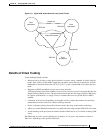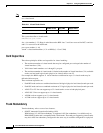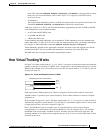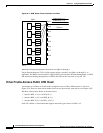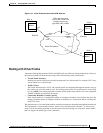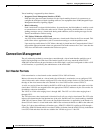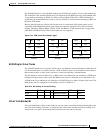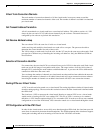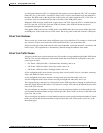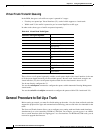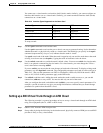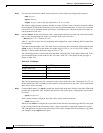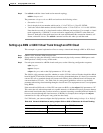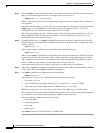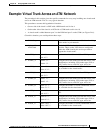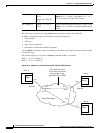
24-11
Cisco BPX 8600 Series Installation and Configuration
Release 9.3.10, Part Number 78-11603-01 Rev. D0, July 2001
Chapter 24 Configuring BXM Virtual Trunks
Connection Management
A virtual path connection (VPC) is configured in the cloud to join two endpoints. The VPC can support
either Cbr, Vbr, or Abr traffic. A unique VP ID per VPC is used to moved data from one endpoint to
the other. The BPX nodes at the edge of the cloud send in cells which match the VPC’sVPIvalue.As
a result the cells are switched from one end to the other of the ATM public cloud.
Within the ATM cloud one virtual trunk is equivalent to one VPC. Since the VPC is switched with just
the VPI value, the 16 VCI bits (from the ATM cell format) of the ATM cell header are passed
transparently through to the other end.
If the public ATM cloud consists of BPX nodes using BXM cards, the access points within the cloud
are BXM ports. If the cloud consists of IGX nodes, the access points within the cloud are UXM ports.
Virtual Trunk Interfaces
The two ends of a virtual trunk can have different types of port interfaces. For example, a virtual trunk
may contain a T3 port at one end of the ATM cloud and an OC-3 port at the other end.
However, both ends of the trunk must have the same bandwidth, connection channels, cell format, and
traffic classes. This requirement is automatically checked during the addition of the trunk.
Virtual Trunk Traffic Classes
All types of traffic from a private network using Cisco nodes are supported through a public ATM cloud.
The Cbr, Vbr, and Abr configured virtual trunks within the cloud should be configured to carry the
correct type of traffic.
• Cbr Trunk: ATM Cbr traffic, voice/data/video streaming, and so on.
• Vbr Trunk: ATM Vbr traffic, frame relay traffic, and so on.
• Abr Trunk: ATM Abr traffic, ForeSight traffic, and so on.
A Cbr configured trunk is best suited to carrying delay sensitive traffic such as voice/data, streaming
video, and ATM Cbr traffic, and so on.
AVbrconfiguredtrunkisbestsuitedtocarryingframerelayandVbrtraffic,andsoon.
An Abr configured trunk is best suited to carrying ForeSight and Abr traffic, and so on.
Two-stage queueing at the egress of virtual trunks to the ATM cloud allows shaping of traffic before it
enters the cloud. However, the traffic is still routed on a single VPC and may be affected by the traffic
class of the VPC selected.
You can configure any number of virtual trunks up to the maximum number of virtual trunks per slot
(card) and the maximum number of logical trunks per node. These trunks can be any of the three trunk
types, Cbr, Vbr, or Abr.
You can configure any number of virtual trunks between two ports up to the maximum number of virtual
trunks per slot and the maximum number of logical trunks per node. These trunks can be any of the
three trunk types.



